Host: Fraser Cain
Guests: Nicole Gugliucci, Jason Major, Amy Shira Teitel, David Dickinson, Elizabeth Howell
Continue reading “Weekly Space Hangout – December 20, 2013: Gaia Launch, Apollo 8 & Emergency Spacewalks”
See the Apollo 8 “Earthrise” in a Whole New Way
One of the most famous images from the history of spaceflight is the picture taken by the crew of Apollo 8 of the “Earthrise” — the first color picture of taken of Earth as it became visible as the spacecraft came from behind the farside of the Moon. The photo was taken 45 years ago on December 24, 1968. It’s been called one of the most influential environmental photographs ever taken, and is one of the most-published pictures ever. As the photographer of this photo, astronaut Bill Anders has said, “We came all this way to discover the Moon. And what we really did discover is Earth.”
The NASA Goddard Scientific Visualization Studio has now released a new video that is a re-creation of that first Earthrise. The video is based on detailed analysis of Apollo 8 photography, including vertical stereo photos that were being taken at the same time as the Earthrise photos, combined with recent topographic models from the Lunar Reconnaissance Orbiter.
“In the video,” space historian Andrew Chaikin — who narrates the new video — told Universe Today, “we see the Moon’s surface, generated from LRO data, exactly as it appeared to the astronauts through the different windows of the spacecraft. We also hear the astronauts’ voices as captured by the spacecraft’s onboard voice recorder, synchronized with the visual. The video reveals new details about this historic event and the resulting color photograph, which became an icon of the 20th century.”
Enjoy this wonderful new video, which explains how this historic image was taken. The visualization shows how Apollo 8 Commander Frank Borman and crew members Anders and James Lovell worked together to photograph the stunning scene as their spacecraft orbited the Moon in 1968. The video allows anyone to virtually ride with the astronauts and experience the awe they felt at the vista in front of them.
The “Earthrise” photo is the cover photo of TIME’s Great Images of the 20th Century, and is the central photo on the cover of LIFE’s 100 Photographs That Changed the World.
“Earthrise had a profound impact on our attitudes toward our home planet, quickly becoming an icon of the environmental movement,” said Ernie Wright, who lead the video project with the SVS.
You can read more details of how the video was put together in this NASA press release.
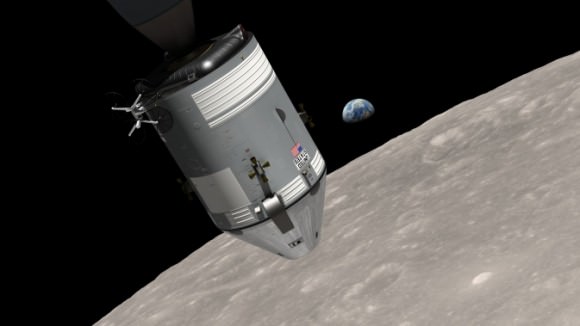
Image Credit:
Ernie Wright/NASA Goddard Scientific Visualization Studio
Visions of Earth through the Yutu Rover’s Eyes
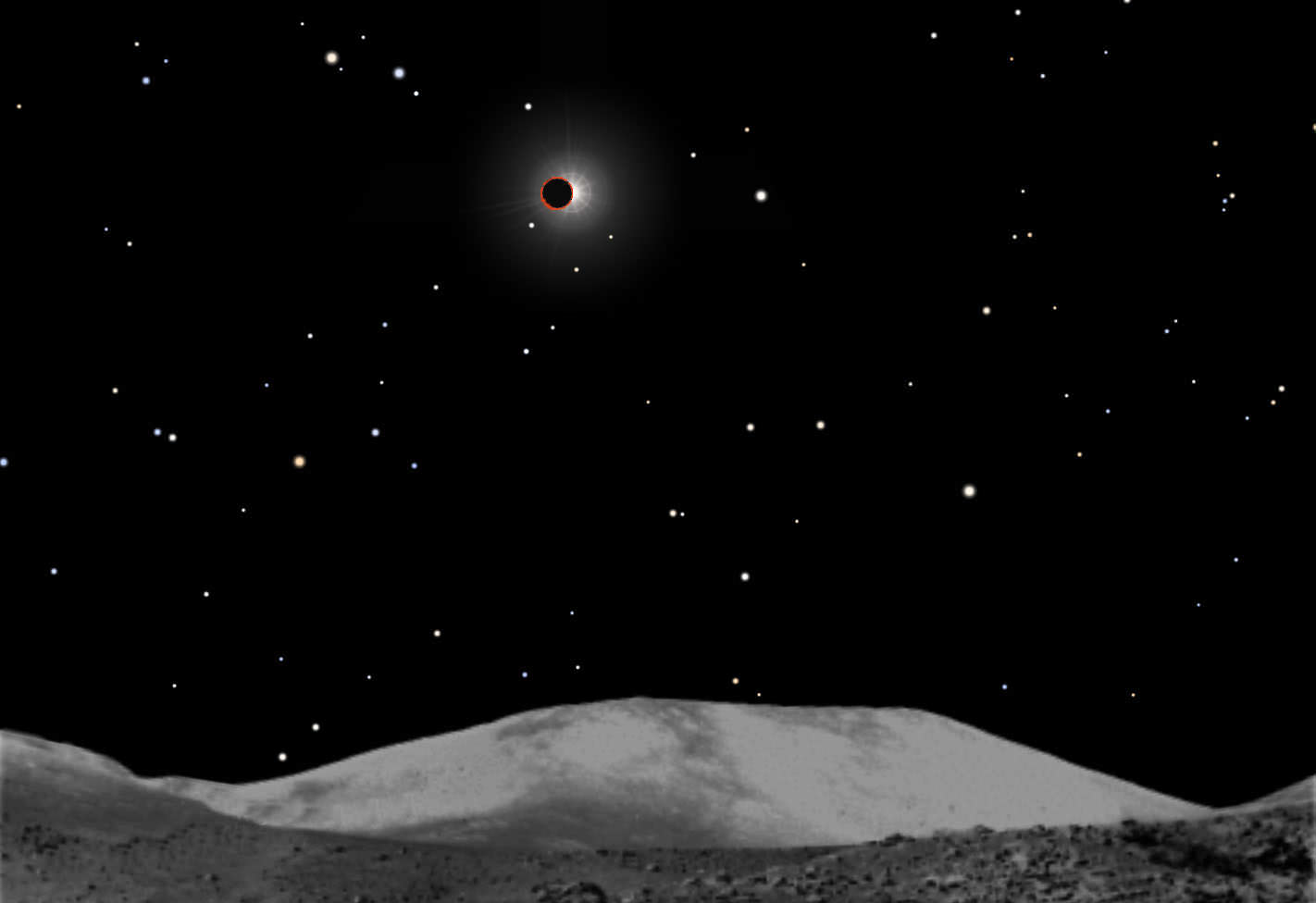
Last night I used my telescope to eye-hike the volcanic plains of the Sea of Rains (Mare Imbrium) where the Yutu rover and lander sit beneath a blistering sun. With no atmosphere to speak of and days that last two weeks, noontime temperatures can hit 250 degrees Fahrenheit (122 C) . That’s hot enough that mission control at the Beijing Aerospace Command and Control Center has decided to draw the shades and give the rover a nap from science duties until December 23 when things cool down a bit.
While studying the subtle gray hues of the Imbrium lava flows I got to wondering what the sky might look like if I could don a spacesuit and visit the landing site “where the skies are not cloudy all day” (to quote a famous song). With no atmosphere to speak of, stargazing can be done both day and night on the moon though I suspect it’s better at night when there’s less glare from your surroundings. Night, defined as the time from sunset to sunrise (no twilights here), lasts about 14.5 Earth days. Days are equally long.
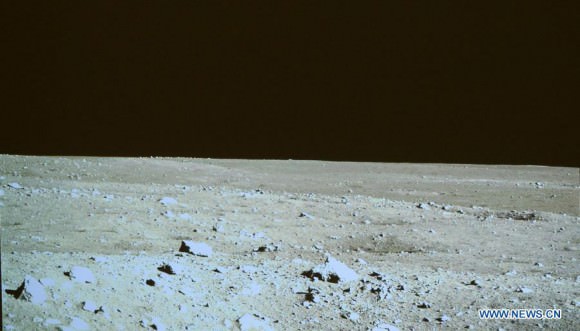
From Yutu’s point of view, it’s very nearly lunar noon today (Dec. 19) with the sun halfway up in the southern sky. Looking at the map of the sky from the lander’s location, you’ll see a few familiar constellations and one very familiar planet – Earth!
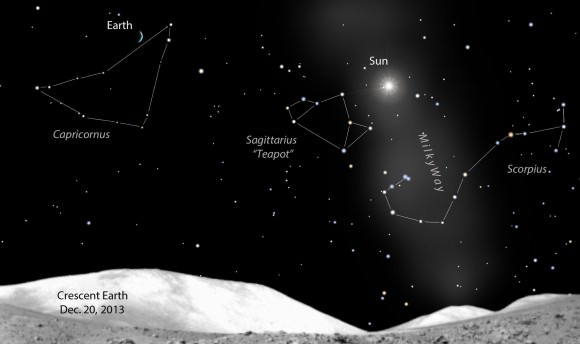
Today Earth appears as a very thin crescent a short distance to the left or east of the sun. Because the moon takes just as long to rotate on its axis as it does to revolve around the Earth, the same face of the moon always faces our planet. Because the two are in synchrony, astronomers call it synchronous rotation.
From the perspective of someone standing on the moon, Earth stands still in one spot of sky throughout the 29.5 day lunar day-night cycle. Well, not perfectly still. Because the moon’s orbit is inclined about 5 degrees to Earth’s orbit and its speed varies along its non-circular orbit, Earth describes a little circle in the lunar sky about 10 degrees in diameter every four weeks.
As the sun slowly moves off to the west, our blue planet remains nearly stationary from Yutu’s perspective and undergoes all the familiar phases we see the moon experience back here on Earth: an evening crescent to start followed by a first quarter Earth, Full Earth last quarter and finally, New Earth. I like the ring of that last one.
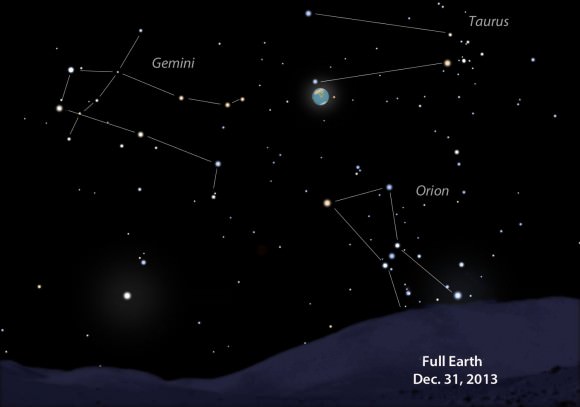
Yutu and the lander will see the sun drift to the west while Earth moves east, rises higher in the lunar sky and putting on the pounds phase-wise. Today Earth’s glides across the border of Sagittarius into Capricornus. The next Full Earth happens on New Year’s Eve when the sun is directly opposite the Earth in the lunar sky.
Full Earth always happens around local midnight or about one week before sunrise during the long lunar day. On the moon the sun is up for about two weeks and then disappears below the horizon for another two weeks before rising again. At Full Earth time, the sun remains hidden around the lunar backside. When the nights are blackest, the bright ball of Earth spreads a welcome blue glow over the desolate landscape.
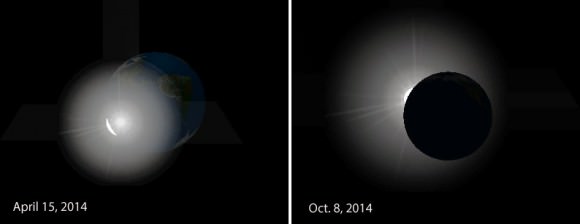
Things really get interesting during lunar eclipses when the moon moves behind the Earth into the planet’s shadow. The next one’s on April 15, 2014. Here on the ground we’ll see the moon gradually munched into by Earth’s shadow until totality, when sunlight from all the sunrises and sunsets around the rim of the planet are refracted by the atmosphere into the shadow, coloring the moon a coppery red.
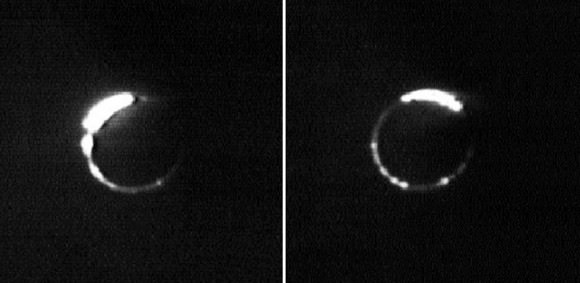
Yutu will see just the opposite. Looking back toward the Earth from inside its shadow, the rover will witness a total eclipse of the sun by the Earth. If by some wonder the Chinese are able to photograph the event, we’ll see photos of the black ball of Earth rimmed in red fire from sunset and sunrise light refracted by our atmosphere. My interpretation using sky mapping software only hints at the wonder of the scene. Beijing Aerospace, if you’re reading this, please make it happen.
Earth eclipses the sun filmed by Japan’s Kaguya lunar orbiter. There are really two eclipses here – the Earth eclipsed by the limb of the moon at the video’s start followed by the solar eclipse.
On two other occasions, our robotic emissaries have photographed solar eclipses from Luna. NASA’s Surveyor 3 snapped a couple crude pictures of the April 24, 1967 eclipse from inside a crater in Mare Cognitium, the Sea that has Become Known. Japan’s orbiting Kaguya probe did the job much more eloquently on video during the February 9, 2009 penumbral lunar eclipse. In a penumbral eclipse (seen from Earth) the moon misses Earth’s dark inner shadow called the umbra, passing only through the outer penumbra, but because the Earth is three times larger than the sun (seen from the moon), it easily covered the sun completely in the complementary total solar eclipse.
And the best thing about watching eclipses from the moon? Guaranteed clear skies!
Smack! A New Crater Appears on the Moon/ Yutu Rover Update
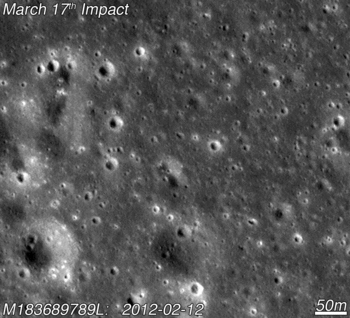
Where there’s smoke, there’s fire, or in this instance, a new hole in the moon. NASA’s Lunar Impact Monitoring Program recorded the brightest meteoroid impact ever in its 8-year history on March 17 this year. The flash of light, as luminous as a 4th magnitude star and lasting about one second, was caught on video striking the moon in the Sea of Rains (Mare Imbrium) not far from the prominent crater Copernicus. Some time after the event, the Lunar Reconnaissance Orbiter (LRO) swept in for a closer look and spied a brand new impact crater.
Since 2005 the program has detected over 300 flashes which are presumed to be from meteoroid impacts.
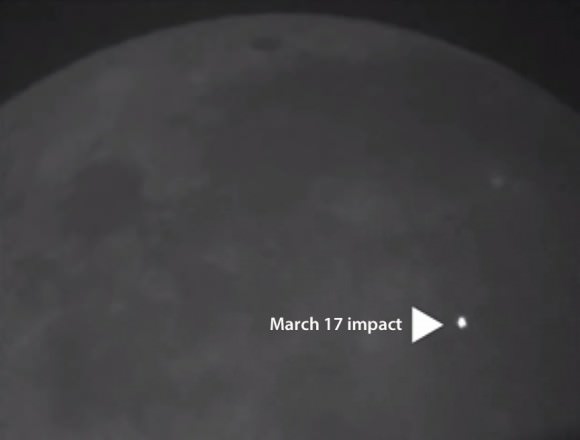
Based on the flash brightness and duration of the St. Pat’s Day smack, the space boulder measured between one to 1.5 feet long (0.3-0.4 meters) and struck the moon traveling at 56,000 mph with a force of 5 tons of TNT. Scientists predicted then that the impact could produce a crater up to 65 feet (20 meters) in diameter.
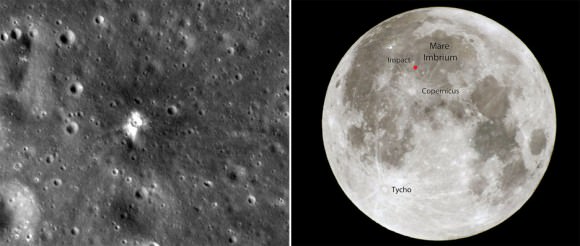
Well, guess what? When LRO dropped by for a look and compared images taken of the flash site before and after March 17. Staring it in the face was a brand new crater 59 feet across (18 meters). Wow! Just look at how reflective the crater and its rays of ejecta appear. That’s all unweathered, fresh dust and rock excavated from beneath the surface courtesy of 5 tons of extraterrestrial TNT. While impressive from LRO’s 31-mile altitude, the “St. Pat” crater is unfortunately invisible in even the largest telescopes from Earth.
Over time, cosmic rays, solar irradiation and micrometeoroids darken and redden the lunar soil. Millions of years from now, the once brilliant crater will blend into the moonscape. Can you imagine how bright larger craters like Tycho and Copernicus must have looked once upon a time?
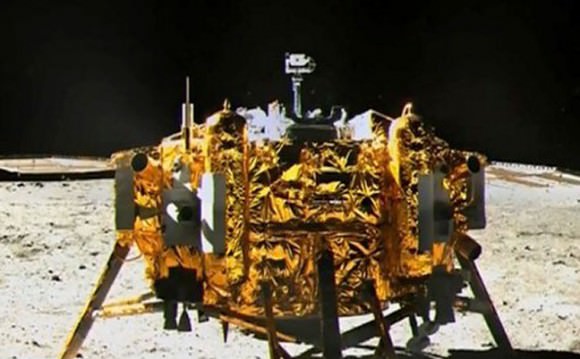
The March 17 impact wasn’t the first new crater seen by LRO, but it does appear to be one of the largest. The LRO camera team has been systematically searching its archive of before and after images for many more lunar landscape changes. Some of those results – including these photos – were presented at the American Geophysical Union Fall Meeting last week; more new craters will be announced in the near future.
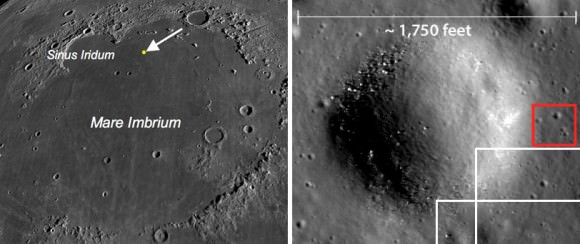
While we’re on the topic of flyover discoveries, NASA will photograph the Chinese Yutu rover and lander when LRO orbits over western Mare Imbrium on Dec. 24 and 25. As it turns out, the lander didn’t land in Sinus Iridium as reported earlier but in nearby Mare Imbrium, a good distance east of the original site but still within the official “landing box”.
Fortuitously, this location turns out to be a great spot to examine young lavas not sampled during the Apollo missions. All the Apollo rocks ranged in age from 3.1 to 3.8 billion years old. Based on crater counts and the flow’s relatively fresh appearance, Yutu sits at the northern edge of a lava sheet dated at between 1 and 2.5 billion years. In lunar years, that’s fresh!
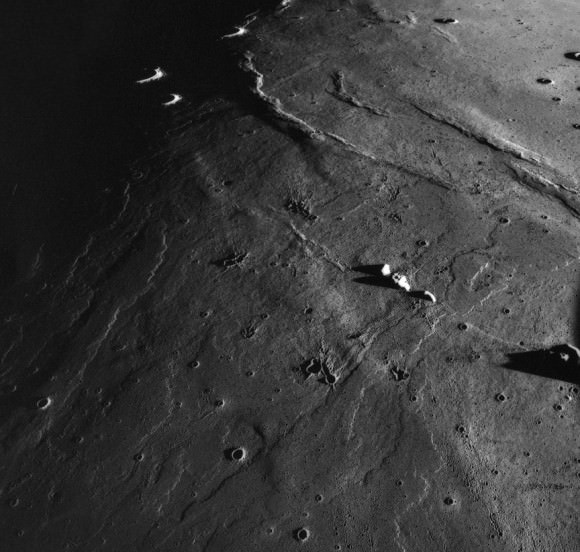
Younger flows experience less erosion, so the lunar bedrock isn’t buried beneath as much rock as at the Apollo sites. Where Yutu sits, the lunar soil or regolith goes down some 6-7 feet (2 meters) instead of 10-26 feet (3-8 meters) at other landing sites. That means easier excavation of much sought after lunar bedrock. We may even be seeing blocks of bedrock littered about the ~35 foot wide crater (10 meters) in one of the first photos sent back to Earth by the Chinese lander.
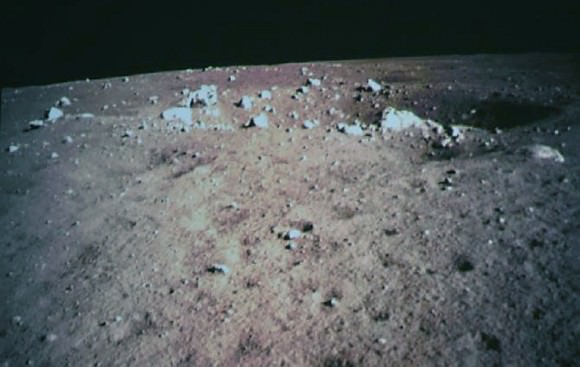
For a great analysis of the Chang’e 3 landing site, I recommend reading A New Site to Explore on the Moon by lunar geologist Paul D. Spudis
Astronomy Cast Ep. 326: Atmospheric Dust
When you consider the hazards of spaceflight, it’s hard to get worked up about dust bunnies. And yet, atmospheric dust is going to be one of the biggest problems astronauts will face when they reach the surface of other worlds. Where does this dust come from, and what does it tell us about the history of other worlds, and what can we do to mitigate the health risks?
Continue reading “Astronomy Cast Ep. 326: Atmospheric Dust”
Virtual Star Party – December 15, 2013 – Blazing Moon, Beautiful Nebulae
Hosts: Fraser Cain and Scott Lewis
Astronomers: David Dickinson, Gary Gonella, Mark Behrendt, Roy Salisbury, Tom Nathe, Stuart Foreman
Continue reading “Virtual Star Party – December 15, 2013 – Blazing Moon, Beautiful Nebulae”
Chinese rover & lander beam back Portraits with China’s Flag shining on Moon’s Surface

Yutu rover emblazoned with Chinese Flag as seen by the Chang’e-3 lander on the moon on Dec. 15, 2013. Notice the rover tire tracks left behind in the loose lunar topsoil. Credit: China Space
Story updated[/caption]
China’s ambitious lunar space exploration program achieved another stunning success Sunday night, Dec 15, when the countries inaugural Chang’e-3 lunar lander and rover beamed back portraits of one another snapped from the Moon’s surface – that also proudly displayed the brilliant red Chinese national flag shining atop an extraterrestrial body for the very first time in human history.
“I announce the complete success of the Chang’e-3 mission,” said Ma Xingrui, chief commander of China’s lunar program, during a live CCTV broadcast as the portraits were shown to a worldwide audience from huge screens mounted at the mission control at the Beijing Aerospace Control Center (BACC) in Beijing.
Chinese President Xi Jinping was on hand to personally witness the momentous events in real time.
A wave of cheers and high fives rocked around mission control as the startling imagery of the ‘Yutu’ rover and Chang’e-3 lander nestled atop the Moon’s soil in the Bay of Rainbows was received around 11:42 p.m. Sunday, local Beijing time, 10:42 a.m. EST, via China’s own deep space tracking network.
Xi Jinping’s presence was a clear demonstration of China’s confidence in its lunar team and the importance of this space spectacular to China’s prestige and technological prowess.
China thus became only the 3rd country in the world to successfully soft land a spacecraft on Earth’s nearest neighbor after the United States and the Soviet Union.
China’s ‘Yutu’ rover had just rolled majestically onto the Moon’s soil hours earlier on Sunday, Dec. 15, at 4:35 a.m. Beijing local time – barely seven hours after the Chang’e-3 mothership touched down atop the lava filled plains of the Bay of Rainbows on Dec. 14.
The rover’s wheels left behind noticeable tire tracks as it drove across the loose lunar topsoil.
Read my earlier detailed accounts of the Dec. 15 drive by Yutu onto the lunar surface illustrated with an extensive photo gallery – here; and of the stunning Dec. 14 landing – here.
CCTV showed China’s President gleefully shaking hands and extending congratulations with many members of the mission team at BACC after seeing the high resolution photos of the Chang’e-3 rover emblazoned with China’s flag for himself.
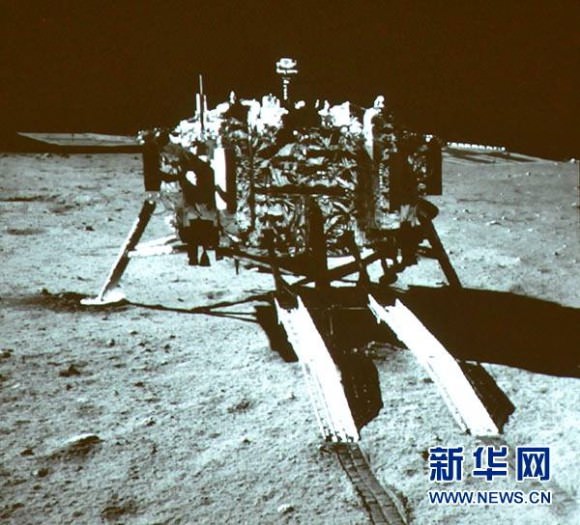
It’s been nearly four decades since the prior lunar landing was accomplished by the Soviet Union’s Luna 24 sample return spacecraft back in 1976.
America’s last visit to the Moon’s surface occurred with the manned Apollo 17 landing mission – crewed by astronauts Gene Cernan and Harrison ‘Jack’ Schmitt , who coincidentally ascended from the lunar soil on Dec. 14, 1972 – exactly 41 years ago.
“The Central Committee of the Communist Party and the Central Military Commission [responsible for China’s space program] sends congratulations to all the staff that participated in the successful completion of the mission and China’s first soft landing on the moon,” said the Chinese vice premier Ma Kai during the CCTV broadcast.
“The rover and lander are working properly and reaching the goals set.”
“Chang’e-3 is China’s most complicated space mission,” said Kai. “This shows China is dedicated to the peaceful uses of space.”
“There are many more complicated and difficult tasks ahead.”
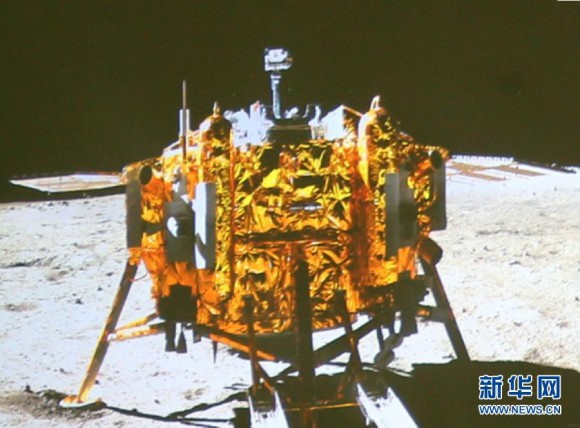
Indeed so far the Chang’e-3 mission has been primarily a highly successful demonstration of the extremely challenging engineering required to accomplish China’s first lunar landing.
Now the science phase can truly begin.
Over 4600 images have already been transmitted by Chang’e-3 since the Dec. 14 touchdown.
After rolling all six wheels into the dirt, Yutu – which translates as Jade Rabbit – drove to a location about nine meters north of the lander, according to CCTV commentators.
The rover then turned around so that the red Chinese flag emblazoned on the front side would be facing the lander’s high resolution color cameras for the eagerly awaited portraits of one another.
Yutu is nearly the size of a golf cart. It measures about 1.5 m x 1 m on its sides and stands about 1.5 m (nearly 5 feet) tall – nearly human height.
The 120 kg Yutu rover will now begin driving in a circle around the right side of the 1200 kg Chang’e-3 lander – for better illumination – at a distance ranging from 10 to 18 meters.
The rover will snap further photos of the lander as it traverses about from 5 specific locations – showing the front, side and back – over the course of the next 24 hours.
See the accompanying graphic – written in Chinese.
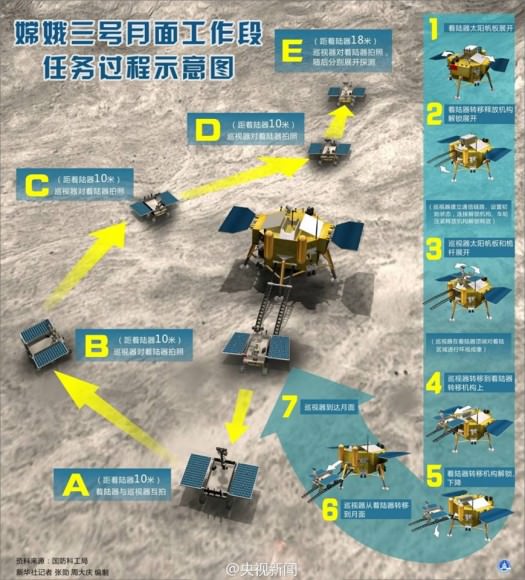
Thereafter Yutu will depart the landing site forever and begin its own lunar trek that’s expected to last at least 3 months.
So the rover and lander will soon be operating independently.
They are equipped with eight science instruments including multiple cameras, spectrometers, an optical telescope, ground penetrating radar and other sensors to investigate the lunar surface and composition.
The radar instrument installed at the bottom of the rover can penetrate 100 meters deep below the surface to study the Moon’s structure and composition in unprecedented detail, according to Ouyang Ziyuan, senior advisor of China’s lunar probe project, in an interview on CCTV.
A UV camera will study the earth and its interaction with solar wind and a telescope will study celestial objects. This is done during the lunar day.
It will also investigate the moon’s natural resources for use by potential future Chinese astronauts.
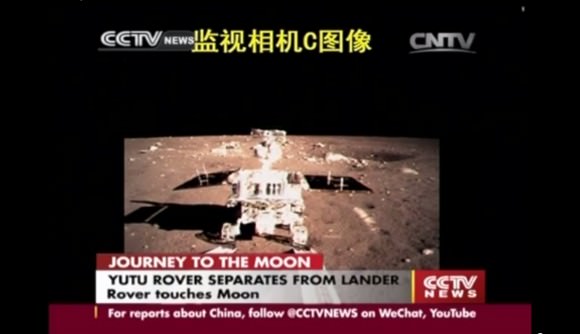
The two probes are now almost fully operational. Most of the science instruments are working including at least three cameras and the ground penetrating radar.
And although they have survived the harsh lunar environment thus far, they still face massive challenges. They must prove that they can survive the extremely cold lunar night and temperature fluctuations of more than 300 degrees Celsius – a great engineering challenge.
The rover will hibernate during the two week long lunar night.
A radioisotopic heater will provide heat to safeguard the rovers computer and electronics – including the alpha particle X-ray instrument on the rover’s robotic arm.
The Bay of Rainbows, or Sinus Iridum region, is located in the upper left portion of the moon as seen from Earth. You can see the landing site with your own eyes.
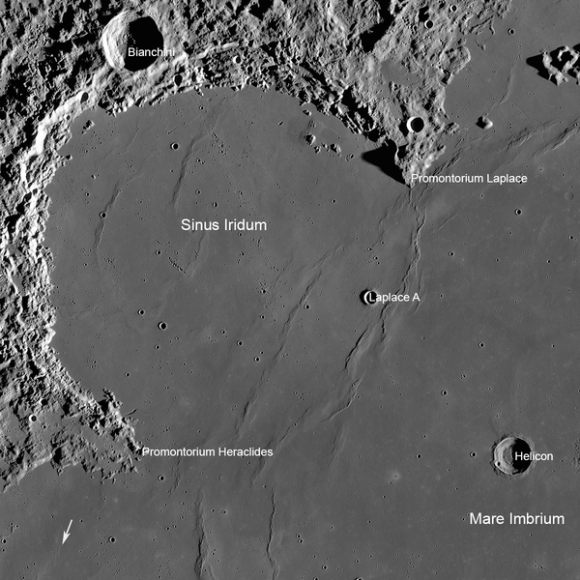
It was imaged in high resolution by China’s prior lunar mission – the Chang’e-2 lunar orbiter and is shown in graphics herein.
China’s Chang’e-3 probe joins NASA’s newly arrived LADEE lunar probe which entered lunar orbit on Oct. 6 following a spectacular night time blastoff from NASA’s Wallops Flight Facility in Virginia.
Stay tuned here for Ken’s continuing Chang’e-3, LADEE, MAVEN, MOM, Mars rover and more news.
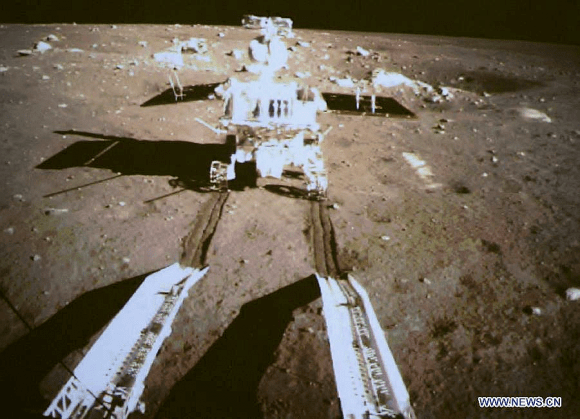
China’s Maiden Lunar Rover ‘Yutu’ Rolls 6 Wheels onto the Moon – Photo and Video Gallery
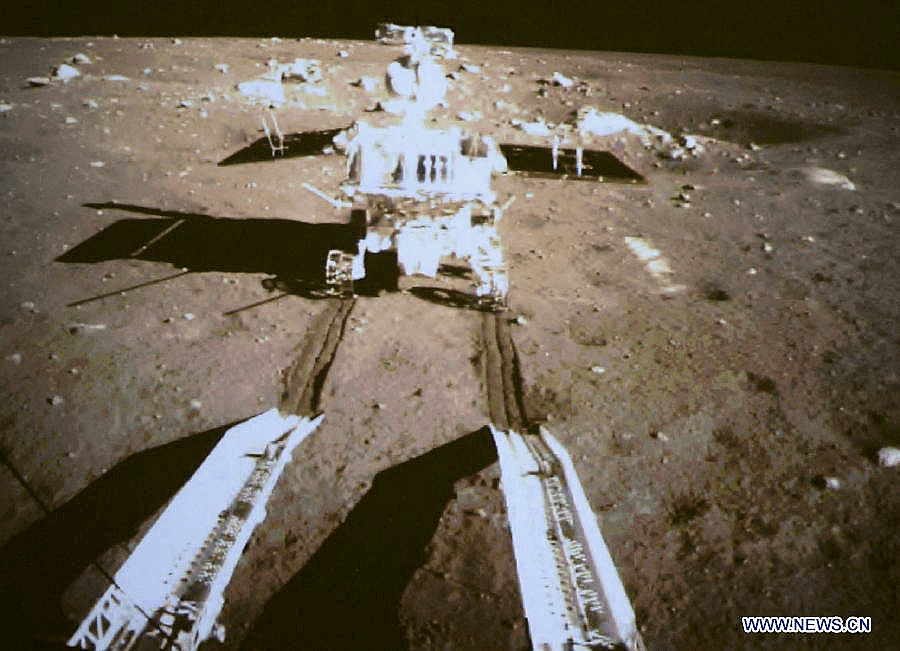
China’s first lunar rover separates from Chang’e-3 moon lander early Dec. 15, 2013. Screenshot taken from the screen of the Beijing Aerospace Control Center in Beijing. Credit: Xinhua/post processing by Marco Di Lorenzo/Ken Kremer
Updated- See below Photo Gallery of Yutu’s descent to lunar surface on Dec. 15, 2013[/caption]
China’s first ever lunar rover rolled majestically onto the Moon’s soil on Sunday, Dec. 15, barely seven hours after the Chang’e-3 mothership touched down atop the lava filled plains of the Bay of Rainbows.
Check out the gallery of stunning photos and videos herein from China’s newest space spectacular atop stark lunar terrain.
The six wheeled ‘Yutu’, or Jade Rabbit, rover drove straight off a pair of ramps at 4:35 a.m. Beijing local time and sped right into the history books as it left a noticeably deep pair of tire tracks behind in the loose lunar dirt.

The stunning feat was broadcast on China’s state run CCTV using images transmitted to Earth from cameras mounted on the Chang’e-3 lander and aimed directly at the rear of the departing moon buggy.
Watch this YouTube video from CCTV showing the separation of ‘Yutu’ from the lander:
The scene was reminiscent of NASA’s Mars Sojourner rover driving of the Mars Pathfinder lander back in 1997.
Chinese space engineers based at the Beijing Aerospace Control Center (BACC) carefully extended a pair of ramps out from the lander in a complex process, drove Yutu onto the ramps and then gently lowered them onto the moon’s soil.
China’s Change’-3 mission had just safely soft landed on the Moon hours only earlier on Saturday, Dec. 14 at 9:11 p.m. Beijing time, 8:11 EST at the Sinus Iridum region, or Bay of Rainbows.
China thus became only the 3rd country in the world to successfully land a spacecraft on Earth’s nearest neighbor after the United States and the Soviet Union.
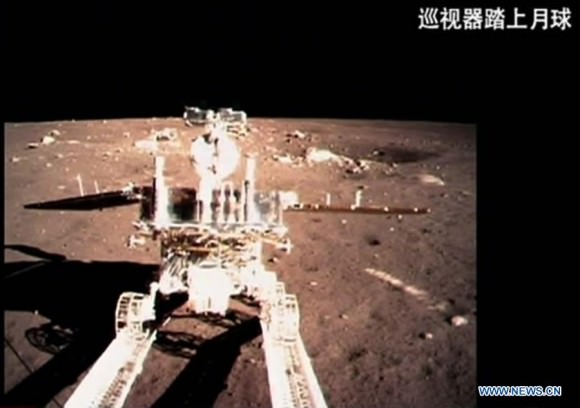
It’s been nearly four decades since the prior lunar landing was accomplished by the Soviet Union’s Luna 24 sample return spacecraft.
Read my detailed account of the Chang’e-3 landing on Dec. 14 – here.
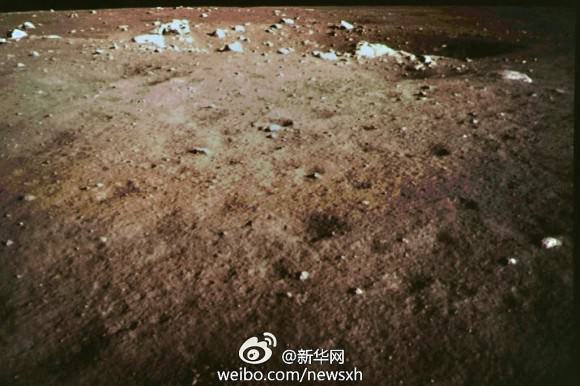
Watch this YouTube video compilation of CCTV’s Dec. 14 landing coverage:
Over 4600 images have already been transmitted by Chang’e-3 in less than a day on the Moon.
Tomorrow, the 120 kg Yutu rover will begin driving in a circle around the 1200 kg lander.
And the pair of lunar explorers will snap eagerly awaited portraits of one another!
The rover and lander are equipped with 8 science instruments multiple cameras, spectrometers, an optical telescope, ground penetrating radar and other sensors to investigate the lunar surface and composition.
The radar instrument installed at the bottom of the rover can penetrate 100 meters deep below the surface to study the Moon’s structure and composition in unprecedented detail, according to Ouyang Ziyuan, senior advisor of China’s lunar probe project, in an interview on CCTV.
China’s Chang’e-3 probe joins NASA’s newly arrived LADEE lunar probe which entered lunar orbit on Oct. 6 following a spectacular night time blastoff from NASA’s Wallops Flight Facility in Virginia.
Stay tuned here for Ken’s continuing Chang’e-3, LADEE, MAVEN, MOM, Mars rover and more news.
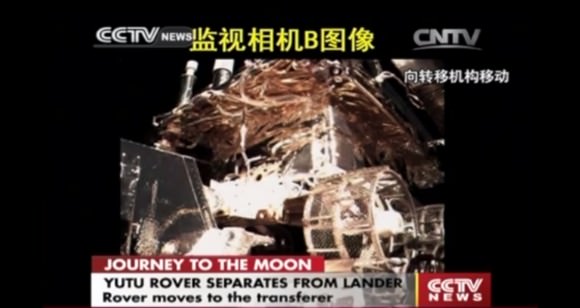
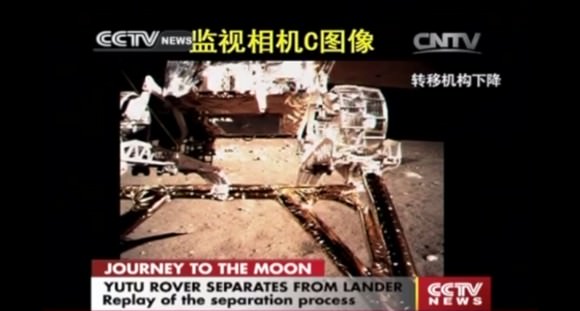
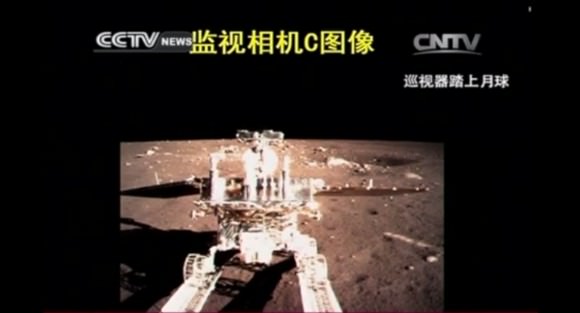
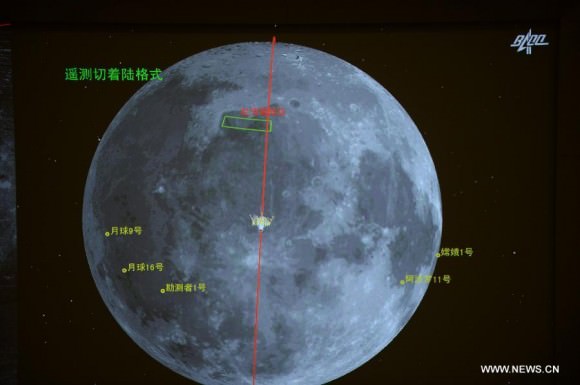
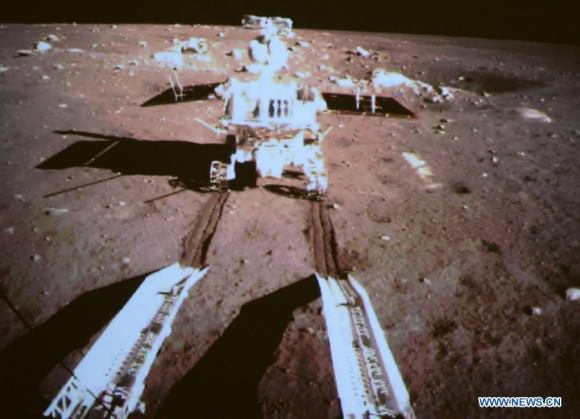
China Scores Historic Success as Chang’e-3 Rover Lands on the Moon Today
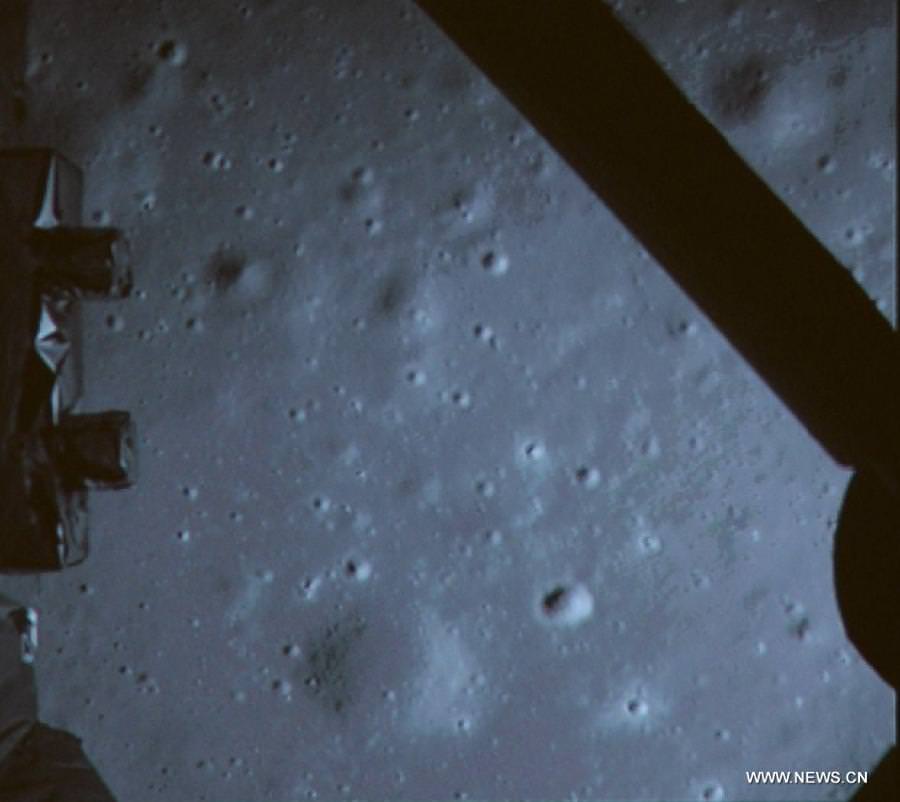
Photo taken on Dec. 14, 2013 shows a picture of the moon surface taken by the on-board camera of lunar probe Chang’e-3 on the screen of the Beijing Aerospace Control Center in Beijing. This marks the first time that China has sent a spacecraft to soft land on the surface of an extraterrestrial body. Credit: Xinhua/CCTV
Story updated[/caption]
China scored a stunning, history making success with the successful touchdown of the ambitious Chang’e-3 probe with the ‘Yutu’ rover on the surface of the Moon today, Dec. 14, on the country’s first ever attempt to conduct a landing on an extraterrestrial body.
The dramatic Chang’e-3 soft landing on the lava filled plains of the Bay of Rainbows occurred at about 8:11 am EST, 9:11 p.m. Beijing local time, 1311 GMT today.
The monumental feat is the first landing on the Moon by any entity in nearly four decades. It was broadcast live on CCTV, China’s state run television network.
Note: Read my related new story with a photo gallery of Yutu’s 6 wheels rolling onto lunar soil – here
This maiden Chinese moon landing marks a milestone achievement for China and clearly demonstrates the country’s technological prowess.
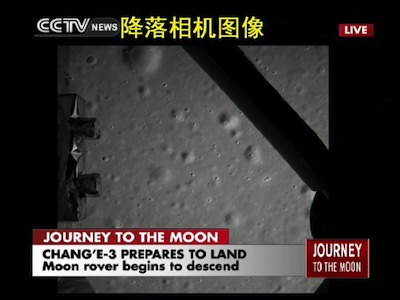 A tidal wave of high fives was unleashed by the huge teams of Chinese space engineers teams controlling the flight from the Beijing Aerospace Control Center (BACC).
A tidal wave of high fives was unleashed by the huge teams of Chinese space engineers teams controlling the flight from the Beijing Aerospace Control Center (BACC).
There was also a huge sense of relief from the nail biting tension upon confirmation of the successful soft landing following many years of hard work and intense planning.
The Chang’e-3 mission entails the first soft landing on the Moon by anyone since the Soviet Union’s unmanned Luna 24 sample return vehicle touched down back in 1976.
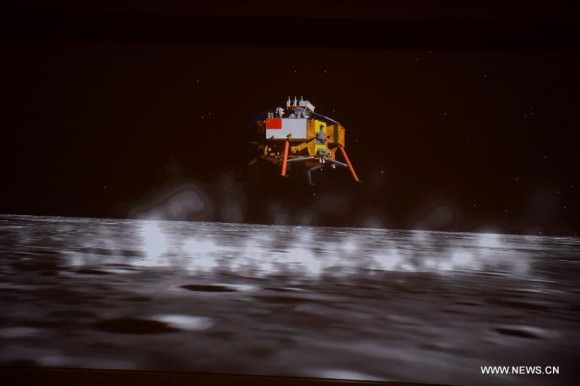
China now joins an elite club of three, including the United States, who have mastered the critical technology required to successfully touch down on Earth’s nearest neighbor.
China’s space vision also stands in total contrast to the utter lack of vision emanating from so called political leaders in Washington, DC who stymie NASA and US science at every opportunity!
‘Yutu’ could very well serve as a forerunner for testing the key technologies required for a Chinese manned lunar landing in the next decade.
In one of its first acts from the surface, the landers life giving solar panels were deployed as planned within minutes of touchdown
The Chang’e-3 mission is comprised of China’s ‘Yutu’ lunar lander riding piggyback atop a much larger four legged landing vehicle.
The Chang’e-3 lander transmitted its first images of the moon in real time during its approach to the lunar surface during the final stages of the ongoing landing operation carried live by CCTV.
A total of 59 images were received instead of the 10 expected, said a CCTV commentator.
The voyage from the Earth to the Moon began 12 days ago with the flawless launch of Chang’e-3 atop China’s Long March 3-B booster at 1:30 a.m. Beijing local time, Dec. 2, 2013 (12:30 p.m. EST, Dec. 1) from the Xichang Satellite Launch Center, in southwest China.
Chang’e-3 made a rocket powered descent to the Moon’s surface today by firing the landing thrusters starting at the altitude of 15 km (9 mi) for a soft landing targeted to a preselected area on the Bay of Rainbows.
The powered descent was autonomous and took about 12 minutes.
The variable thrust engine can continuously vary its thrust power between 1,500 to 7,500 newtons. It was the biggest ever used by China in space said a commentator on CCTV.
The variable thrust engine enabled Chang’e-3 to reduce its deceleration as it approached the moon.
The descent was preprogrammed and controlled by the probe itself, not from the ground.
A descent camera was mounted on the lander’s belly
The 1200 kg lander is equipped with unprecedented terrain recognition equipment and software to hover above the landing site and confirm it was safe. This enabled the craft to avoid rock and boulder fields that could spell catastrophe even in the final seconds before touchdown if the vehicle were to land directly on top of them.
The descent engine fired until the lander was about hovering 100 meters above the lunar surface.
After determining it was safe to proceed, the lander descended further to about 3 meters. The engine then cut off and the lander free fell the remaining distance. The impact was cushioned by shock absorbers.
The solar panels soon unfurled. They are the most efficient Chinese solar panels available, said a CCTV commentator.
The Bay of Rainbows, or Sinus Iridum region, is located in the upper left portion of the moon as seen from Earth. You can see the landing site with your own eyes.
It was imaged in high resolution by China’s prior lunar mission – the Chang’e-2 lunar orbiter – and is shown in graphics herein.
The Yutu rover is also unfurling its solar panels and mast today.
Yutu, which translates as Jade Rabbit, stands 150 centimeters high, or nearly 5 feet – human height.
It weighs approximately 120 kilograms and sports a robotic arm equipped with advanced science instruments.
On Sunday, the six-wheeled ‘Yutu’ rover with a rocker bogie suspension similar to NASA’s Mars rovers will be lowered in stages to the moon’s surface in a complex operation and then drive off a pair of landing ramps to explore the moon’s terrain for at least three months.
In what promises to be a space spectacular, the lander and rover are expected to photograph one another soon after Yutu rolls onto the Bay of Rainbows.
They will work independently.
The rover and lander are equipped with multiple cameras, spectrometers, an optical telescope, ground penetrating radar and other sensors to investigate the lunar surface and composition.
The radar instrument installed at the bottom of the rover can penetrate 100 meters deep below the surface to study the Moon’s structure and composition in unprecedented detail, according to Ouyang Ziyuan, senior advisor of China’s lunar probe project, in an interview on CCTV.
The Chang’e-3 lander is powered by a combination of solar arrays and a nuclear battery said CCTV, in order to survive the two week long lunar nights.
Chinese space officials expect the lander will function a minimum of 1 year.
ESA’s network of tracking stations are providing crucial support to China for Chang’e-3 from launch to landing.
China’s Chang’e-3 probe joins NASA’s newly arrived LADEE lunar probe which entered lunar orbit on Oct. 6 following a spectacular night time blastoff from NASA’s Wallops Flight Facility in Virginia.
Stay tuned here for Ken’s continuing Chang’e-3, LADEE, MAVEN, MOM, Mars rover and more news.
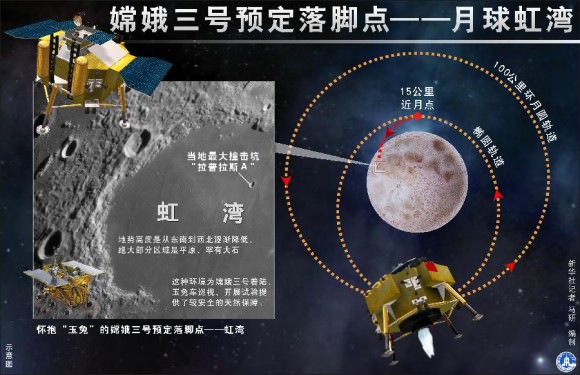
China’s Chang’e-3 Moon Rover Descends to Lower Orbit Sets Up Historic Soft Landing
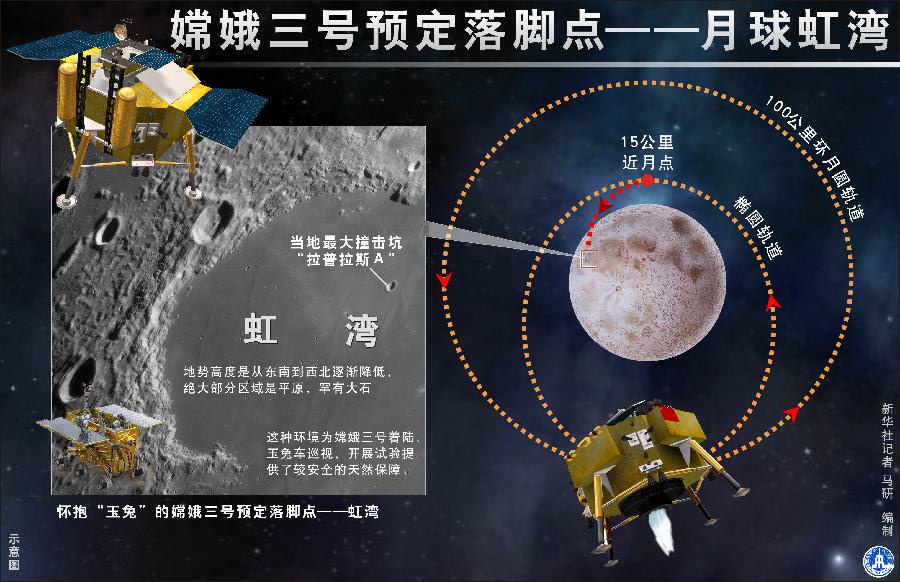
All systems appear to be “GO” for the world’s first attempt to soft land a space probe on the Moon in nearly four decades.
China’s maiden moon landing probe – Chang’e-3 – is slated to attempt the history making landing this weekend on a lava plain in the Bay of Rainbows, or Sinus Iridum region.
Chinese space engineers at the Beijing Aerospace Control Center (BACC) paved the way for the historic touchdown by successfully commanding Chang’e-3 to descend from the 100 km-high lunar circular orbit it reached just one week ago on Dec. 6, to “an elliptical orbit with its nearest point about 15 km away from the moon’s surface”, according to a statement from China’s State Administration of Science, Technology and Industry for National Defense (SASTIND).
UPDATE: CCTV is providing live landing coverage
The first pictures taken from the alien lunar surface in some 37 years are expected to be transmitted within days or hours of touchdown planned as early as Saturday, Dec. 14, at 9:40 p.m. Beijing local time, 8:40 a.m. EST.
CCTV, China’s state run network, carried the launch live. It remains to be seen whether they will have live coverage of the landing since there have been no programming announcements.
SASTIND said the orbit lowering thruster firing was “conducted above the dark side of the moon at 9:20 p.m.” on Dec. 10, Beijing local time.
Confirmation of the Chang’e-3 probes new, lower orbit was received four minutes later.
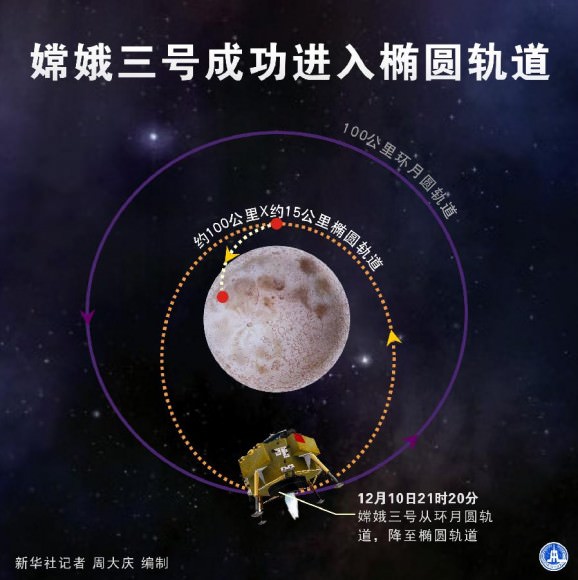
If successful, the Chang’e-3 mission will mark the first soft landing on the Moon since the Soviet Union’s unmanned Luna 24 sample return vehicle landed back in 1976.
China would join an elite club of three, including the United States, who have mastered the critical technology to successfully touch down on Earth’s nearest neighbor.
The Chang’e-3 mission is comprised of China’s ‘Yutu’ lunar lander riding piggyback atop a much larger four legged landing probe.
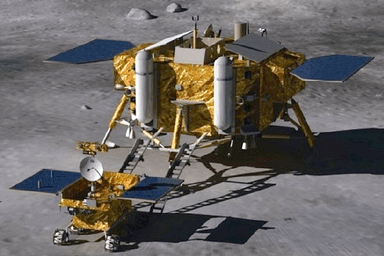
The voyage from the Earth to the Moon began 12 days ago with the flawless launch of Chang’e-3 atop China’s Long March 3-B booster at 1:30 a.m. Beijing local time, Dec. 2, 2013 (12:30 p.m. EST, Dec. 1) from the Xichang Satellite Launch Center, in southwest China.
Chang’e-3 will make a powered descent to the Moon’s surface on Dec. 14 by firing the landing thrusters at the altitude of 15 km (9 mi) for a soft landing in a preselected area on the Bay of Rainbows.
The powered descent will take about 12 minutes.
The variable thrust engine can continuously vary its thrust power between 1,500 to 7,500 newtons, according to Xinhua.
The Bay of Rainbows is located in the upper left portion of the moon as seen from Earth. It was imaged in high resolution by China’s prior lunar mission – the Chang’e-2 lunar orbiter.
The 1200 kg lander is equipped with terrain recognition equipment and software to avoid rock and boulder fields that could spell catastrophe even in the final seconds before touchdown if the vehicle were to land directly on top of them.
Chang’e-3 is powered by a combination of solar arrays and a nuclear device in order to survive the two week long lunar nights.
The six-wheeled ‘Yutu’ rover, with a rocker bogie suspension, will be lowered in stages to the moon’s surface in a complex operation and then drive off a pair of landing ramps to explore the moon’s terrain.
Yutu measures 150 centimeters high and weighs approximately 120 kilograms and sports a robotic arm equipped with science instruments.
The rover and lander are equipped with multiple cameras, spectrometers, an optical telescope, ground penetrating radar and other sensors to investigate the lunar surface and composition.
The radar instrument installed at the bottom of the rover can penetrate 100 meters deep below the surface to study the Moon’s structure and composition in unprecedented detail.
China’s Chang’e-3 probe joins NASA’s newly arrived LADEE lunar probe which entered lunar orbit on Oct. 6 following a spectacular night time blastoff from NASA’s Wallops Flight Facility in Virginia.
Stay tuned here for Ken’s continuing Chang’e-3, LADEE, MAVEN, MOM, Mars rover and more news.

